Carolus Linnaeus
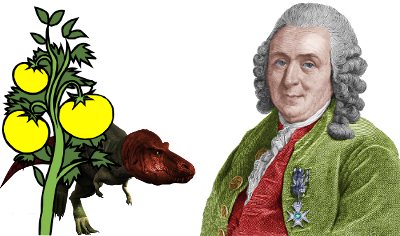
Lived 1707 – 1778.
Carolus Linnaeus is one of the giants of natural science. He devised the formal two-part naming system we use to classify all lifeforms.
A well-known example of his two-part system is the dinosaur Tyrannosaurus rex; another is our own species Homo sapiens.
Linnaeus pushed the science of biology to new heights by describing and classifying our own human species in precisely the same way as he classified other lifeforms. Other people at the time demanded that humans must be regarded as a special case in biology, different from animals.
Early Life and Education
Carl Linnaeus was born on May 23, 1707 in the village of Råshult in southern Sweden. His father was Nils Ingemarsson Linnaeus, a church minister and amateur botanist; and his mother was Christina Brodersonia.
His father believed that the best thing he could offer his children was a solid education and, in addition to botany, taught Carl about religion and to speak Latin before the young boy could walk.
Carl paid close attention to his father’s activities. He soon picked up his father’s love of plants and botany; he began growing his own plants in his family’s generously sized garden, and walking further afield searching for new plants.
His father recognized that Carl had a good mind. To improve his education he brought in a private tutor when the boy was seven.
In comparison with lessons given by his father, and his days in the garden and countryside cultivating and searching for plants, Carl found the tutor’s work very dull.
Carl Linnaeus started school at the age of 10. He was not a bad student, but he did not excel. He continued to work hard on his own private botanical studies.
By the end of his secondary schooling, his teachers had formed the opinion that he was not bright enough to go to university. His immense interest in and knowledge of botany were ignored – it was not a ‘proper subject.’ His teachers expected their students to be skillful in Greek, Hebrew, mathematics and theology, but Carl was not especially interested in these subjects.
Fortunately, one of his school teachers, Johan Rothman, who was also a medical doctor, recognized the boy’s talents and advised his father that Carl should aim for a career in medicine. Carl moved into the Rothman family home, where Rothman gave him formal lessons in anatomy and physiology as well as botany.
By the age of 21, Linnaeus was ready for university.
He enrolled at Lund University using the Latin form of his name, Carolus Linnaeus. This was common practice for students in Europe. For example, centuries earlier, when Mikolaj Kopernik enrolled at university in Poland, he took the Latin name Nicolaus Copernicus.
After just one year at Lund University, Linnaeus switched to Uppsala University, because Rothman told him the medicine and botany courses were better at Uppsala. This proved to be untrue, but actually worked out well for Linnaeus.
After studying at Uppsala for a year, Linnaeus wrote up some of his thoughts and observations on reproduction in plants. One of Uppsala’s medical professors, Olof Rudbeck, read what Linnaeus had written.
The courses at Uppsala were so bad that Rudbeck formed the view that the second year student Linnaeus knew more about botany than the lecturers! In 1730, aged just 23, Linnaeus became a botany lecturer at Uppsala University. He turned out to be a rather good teacher, and his lectures were popular.
His mother, who had always been unhappy that her eldest son had not been good enough to study theology at university, now consoled herself that he had become a university lecturer – and at such a young age!
Carolus Linnaeus: The Science
Lapland, New Species, Classifying and Naming Plants
In the winter of 1730/31 Linnaeus continued working hard on botany in Uppsala. In particular, he had grown dissatisfied with the way plant species were classified. He began making notes about how he could improve this.
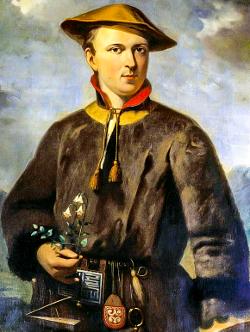
Carolus Linnaeus dressed as a native Sami in Lapland. The plant in his right hand is the Linnaea borealis, named in his honor. This was his favorite plant of all.
In 1732 he was awarded funding for an expedition to Lapland, in the far north of Sweden.
From May to October that year the 25 year-old botany lecturer traveled 1250 miles (2000 km) in Lapland, making observations of the native plants and birds. He also made geological notes.
On this journey he discovered about 100 new plants.
He wrote a book about Lapland’s plants called Flora Lapponica, describing his new discoveries. He also started using a two-part naming system – which would eventually become the Linnaean or binomial system, used worldwide to name living things.
It also came to him that he could use his new system to name animals as well as plants.
The Netherlands and a Medical Doctorate
In 1735, aged 28, Linnaeus traveled to the University of Harderwijk in the Netherlands to get a doctoral level degree in medicine. Harderwijk was famous for awarding degrees very quickly. Linnaeus had already written a thesis in Uppsala about malaria and its causes, which he submitted to Harderwijk. Within two weeks he had diagnosed a patient, defended his thesis, and become a doctor of medicine!
Systema Naturae
In the Netherlands Linnaeus met Johan Frederik Gronovius, a Dutch botanist. He showed Gronovius his recent writings on the classification and naming of plants. Linnaeus had replaced some very lengthy plant names with logical, much shorter, two-part names.
Gronovius saw that Linnaeus’s work could transform botany. He became very excited.
He wanted to get the book published as quickly as possible. He contacted his friend Isaac Lawson, a Scottish doctor, and together Gronovius and Lawson paid for Linnaeus’s work to be published. And so in 1737 the first edition of Systema Naturae (System of Nature) came to the world.
Over the years, Linnaeus continued to develop his ideas and add new species so that Systema Naturae grew in a period of about 30 years from 12 outsize pages in its first edition to 2400 pages in its twelfth edition. This was the first serious attempt ever made to document all of our planet’s species. It was a huge effort: Linnaeus took the apparently chaotic natural world and organized it, making it easier for everyone to understand it.
The classification of lifeforms is called taxonomy. Linnaeus classified living things by looking for similarities. For example he would look at the teeth of different mammals to decide if they were related. In modern times, DNA is used to classify lifeforms. In the case of fossils, where no DNA is present, scientists still use similarities between fossils – and between fossils and current lifeforms – to classify them.
After publishing Systema Naturae, Linnaeus also visited England and France, where he met other scientists, collected specimens, and discussed his work.
Linnaeus was not a modest man. He was well-aware of his achievements, and in later life, he wrote of himself:
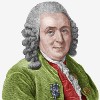 “No one has been a greater botanist or zoologist. No one has written more books, more correctly, more methodically, from personal experience. No one has more completely changed a whole science and started a new epoch.”
“No one has been a greater botanist or zoologist. No one has written more books, more correctly, more methodically, from personal experience. No one has more completely changed a whole science and started a new epoch.”
CAROLUS LINNAEUS
Physician and President of the Royal Swedish Academy of Science
Linnaeus returned to Sweden in 1738, becoming a physician in the nation’s capital city, Stockholm. While in Stockholm, Linnaeus helped found the Royal Swedish Academy of Science and became its first president.
Professor of Botany
In 1741, aged 34, Linnaeus returned to Uppsala University and became a full professor of medicine, taking control of botany, natural history and the university’s botanical garden. He immediately undertook a one-month visit to the Swedish island of Gotland with some of his new students, where together they discovered 100 new plant species.
In summertime, Linnaeus would take his botany students on walks around Uppsala to observe and record the plant and animal life they found. This was almost a return to his early boyhood adventures, when he walked freely in the countryside searching for plants.
When he gave his first lectures in Uppsala as a 23 year-old student, they had been popular. Now, as an older professor, his lectures were even more popular, and he held some of them in the botanical garden. His students were captivated by Linnaeus’s enormous enthusiasm for botany and nature.
In 1750, at the age of 43, Linnaeus was appointed as Uppsala University’s rector.
Species Plantarum – Transforming Biology
In 1753, Linnaeus published his natural science masterpiece in two volumes and 1200 pages: Species Plantarum (Plant Species). In this work, he listed all the plant species that had been discovered at that time – almost 6000 – and classified them into about 1000 appropriate genera. This enabled him to use two-part names for every plant in Species Plantarum – the first time all plants had been named in this way.
Many of the plants in the two volumes had been discovered by Linnaeus’s own students. A select group of his best students (who became known as the Apostles) traveled the world spreading the word about Linnaeus’s two-part naming system, and describing new plant species, many of which they sent as specimens back to Linnaeus in Uppsala. The Apostles traveled to wild and remote places. Out of 17 Apostles, 7 died on expeditions.
In 1758, Linnaeus published the tenth edition of Systema Naturae in which he classified all the animal kingdom into genera and gave all the species two-part names.
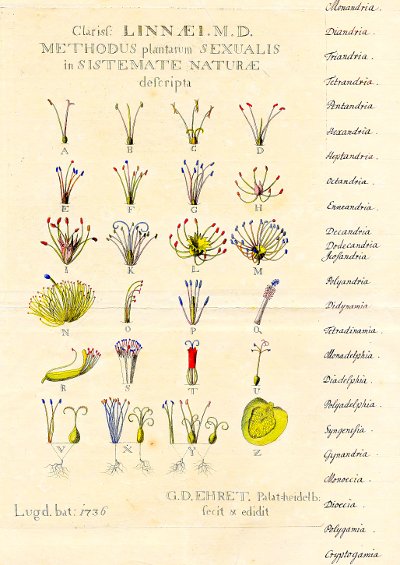
Plant drawings from Systema Naturae. Linnaeus organized plants into 24 classes. This illustration shows his readers how to tell the difference between these classes.
During his career, Linnaeus named about 13,000 lifeforms and classified them into suitable categories such as mammals, birds, fish, primates, canines, etc.
Other Notable Contributions
• Linnaeus modified the Celsius temperature scale into the form we use today. The scale had been invented by his compatriot, Anders Celsius, who had said 0 °C was the boiling point of water and 100 °C was water’s freezing point. Linnaeus realized that it would be more useful if these values were reversed and persuaded the rest of the scientific world to follow his example.
• Linnaeus was the first person to place humans in the primate family and to describe bats as mammals rather than birds. Linnaeus did not categorize humans alongside apes with any idea of an evolutionary link. He did it with the same reasoning he used to categorize all life, which was similarities he identified between species.
• Linnaeus was one of the founders of the science of ecology, describing the relationship between living organisms and their environments.
• Linnaeus’s idea of going on expeditions to study nature and gather specimens inspired Charles Darwin and Alfred Russel Wallace to go on expeditions that led to their theories of evolution by natural selection.
• Linnaeus invented index cards. He did this in response to his ever-growing lists of species which required a cataloging method that was easily expandable and easy to reorganize.
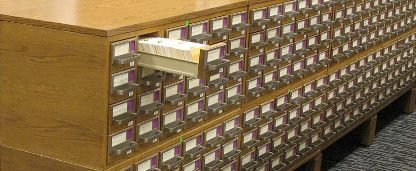
Linnaeus invented the index card system to record and store data.
The End
Carolus Linnaeus was knighted by the King of Sweden in 1761 and took the nobleman’s name of Carl von Linné.
He died at the age of 70, on 10 January, 1778, after suffering a stroke. He was survived by his wife Sara, and five children. Two of the couple’s other children died when they were very young.
Linnaeus died on his farm about 6 miles (10 km) from Uppsala. He had bought the farm 20 years before his death. The farm was called Hammarby. Linnaeus cultivated his own private gardens at Hammarby and had hoped to be buried there. In fact he was buried in Uppsala.
Today Hammarby is a museum which features exhibitions of Linnaeus’s work, his botanical collections, and a garden and a park where his love of the natural world is reflected.
No comments:
Post a Comment